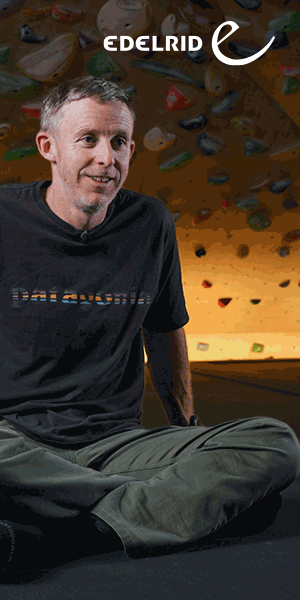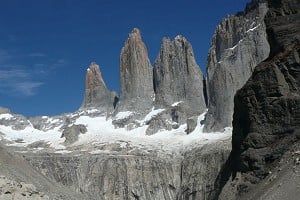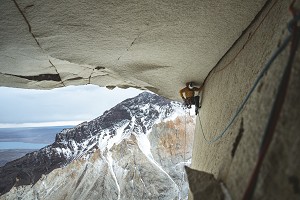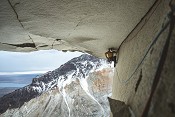
Rolando Garibotti provides a detailed summary of climbing activity in Southern Patagonia during the 2018/19 season, originally posted on his Pataclimb website. Further information and photos can be found in the links provided on the Pataclimb homepage, where each peak and route is listed individually.
This past summer season was the third in a row with fairly poor weather and conditions. After having anomalously dry seasons in 2012, 2015 and 2016, it has come as a bit of a shock to go back to average Patagonia weather. The only extended windows of good weather were at the start and end of the season, in November and in March/April.
In early October, Martín Elias, Francois Poncet and Jerome Sullivan did the first ascent of the south pillar of Cerro San Lorenzo, a 1200-meter tall rock tower that was likely one of the hardest virgin summits left in southern Patagonia. Several parties had attempted the northeast face of this tower, but retreated after a handful of pitches. Jerome and partners approached from the north tackling the left side of the east face to then move on to the south face. The rock quality of this formation is terrible, so they followed the path of least resistance. The crux was a two-pitch chimney with terrible rock that required difficult aid. They called their route "La Milagrosa", 1200m M7 A3 6a.
In the Chalten Massif the ascent of the season came at its tail end, when Jim Reynolds free-soloed up and down Agujas Rafael Juárez and Saint Exúpery, and Cerro Fitz Roy. In the early 1900s, Paul Preuss, considered by many "the father of style" had preached and practised free-soloing up and down peaks as the "honest, sporting" way to climb (his words). He argued that one should "overcome difficulties with your own strength, on ascent and descent alike," explaining that "if there is someplace you can't go down, you should also not go up." One could have never imagined that Preuss's maxims would be one day applied to a peak like Cerro Fitz Roy.
On Aguja Rafael Júarez, Jim soloed the complete West Ridge (1000m 6b) and down-climbed the Anglo-American (350m 6b), while on Aguja Saint Exúpery he free-soloed Chiaro di Luna (750m 6b+) and down-climbed the Kearney- Harrington (550m 6a+). On Cerro Fitz Roy he free-soloed the Afanassieff routeon the northwest ridge (1500m 6a+), taking 6:38hs to reach the summit and 8:30hs to down-climb the same route. He carried a rope and some gear, which he did not use, but he forgot his harness and belay device. He described his approach as the "best possible form of the art".
There were other noteworthy ascents in the Chalten Massif. On Aguja Poincenot, Siebe Vanhee completed the first free ascent of Patagonicos Desesperados (500m 7a+), which was onsighted a week later by Leonardo Gheza. There were two ascents of the Southeast Ridge of Cerro Torre, by French and Slovak teams, the seventh and eights ascents of the route. Elsewhere on Cerro Torre, Jorge Ackermann, Tomas Aguilo, and Korra Pesce made an attempt on a difficult line on the left side north face, climbing a total of twenty three pitches, nine on the north face and three above Aguilo's 2013 high-point on the same line. High winds and high temperatures forced them to retreat from the base of the final headwall, which will likely be the crux of the route. The French team from the École Militaire de Haute Montagne in Chamonix, Léo Billon and Max Bonniot, who repeated the Southeast Ridge of Cerro Torre also repeated El Corazón on the east face of Cerro Fitz Roy, completing the fifth ascent of the route.
Several smaller new routes were put up in the Chalten Massif. On Cerro Solo, Pedro Fina and Gustavo Tomaschewski Netto climbed "Alpinisisima" following the north ridge, 500m 5 50˚. On El Mochito, after attempts with various partners, Matías Korten rope-soloed "El Camino del Guerrero", 280m 5.10c A1; Christopher Koppl rope-soloed "Straight outta Nipo", 300m 5 A3+; and Koppl together with Vitaliy Musiyenko climbed "Mosca para Mujer", 300m 5 A3. On El Mocho, Ondrej Huserka and Jozef Kristoffy did the second ascent and first free ascent of Bizcochuelo, finding difficulties to 7a+. On the north face of Aguja de la Medialuna, Kiff Alcocer and Jordon Griffer climbed "Harvest Moon," 250m 6b.
On the west face of Torre Egger, Alessandro Beltrami, Mirko Povinelli, Giorgio Roat, and Ermanno Salvaterra made a valiant attempt in the centre of the west face, climbing two thirds of the way up what is a very steep and fairly blank big-wall. Over two attempts they spent 21 days on the wall on porta-ledges, retreating when their time and food run out. This was Ermanno's fourth attempt of this line, which he hopes to try yet again. On the east face of Torre Egger, Brette Harrington and Quentin Lindfield Roberts climbed the first three pitches of Titanic, then moved left onto virgin ground, climbing nine new pitches to rejoin Titanic at the snowfield half way up the wall, from where they retreated. They called their variation "Marc-André's Vision", as it was Marc-André Leclerc who first eyed this line. They hope to return to complete their line to the summit, possibly connecting into Titanic.
On the northeast face of Aguja Bífida, Juan Canale, Jonathan Larrañaga, and Oriol Baro climbed a variation connecting The Siren to Cogan (six pitches, 6a+), while Jon Griffin, Tad McCrea, and Luis Scheinkman climbed an alternate start to Cogan (five pitches, 6a C1). On the west face of El Tridente, Martin Lopez Abad, Julian Ferhmann and Diego Simari climbed "El Hedonista", six new pitches starting from and connecting to "The Secret of the Mountain," following a very good looking line in the central pillar (to 6b+). On the west face of Aguja Rafael Juárez, Ryo and Sayaka Masumoto climbed a direct finish to Quilombo, finding difficulties to 7a. On Aguja de l'S, Iker and Eneko Pou climbed "Haizea", seven new pitches in the centre of the east face.
To the southwest of Lago Viedma, and to the east of Cerro Moyano, in an area seldom visited, Daniel Pons and Steffen Welsch did the first ascent of the southern most summit of the chain of which is also part Cerro Huemules. They started from Estancia Helsingfors, walking along the Moyano fjord, taking a side valley immediately west of Cerro Huemules to establish camp after walking six hours, at around 1300 metres. The next day they walked to the base of the northwest face of the unclimbed peak, started climbing at 2100m, doing eight short pitches with difficulties to 5+ and A0. They note that the summit is clearly higher than Cerro Huemules itself, and measured it with an altimeter at 2350m. They christened the peak Nahumaday.
The Torres del Paine Massif in Chile also saw some new route action. Earlier in the year, in June 2018, Max Didier and Cristobal Señoret climbed "Estilo Andino", a new route on Cerro Paine Grande's 300m-tall southwest face. Their line climbs to the far left of the existing lines, reaching the heavily rimmed west ridge, which it follows to the summit. They found difficulties to 90˚ and WI4. This was only the fifth ascent of this imposing, beautiful peak which at 2,845 metres, is the highest peak in the Torres del Paine massif. In August, during the winter, Felipe Bishara and Christian Barra Muñoz climbed a new route on the southeast face of Cerro Almirante Nieto. The difficulties begin around 1300 metres, with a 10-pitch long ramp that is followed by eight pitches of mixed climbing and unconsolidated snow with several sections to 75˚ and steps to 90˚. They did the ascent non-stop, taking 31.5 hours round-trip from their car. Also in August, Nicolás Secul and Cristobal Señoret did the first ski descent of the east face of Almirante Nieto, following the line of Genesis, a route put up in 2015.
During the summer season, Secul and Señoret climbed a new route on the southwest face of Cerro Peineta. "Puro Filete" climbs nine pitches on the far right side of the face, with difficulties to 6c A1. On the east face of Cuerno Este, Secul and León Riveros climbed seven new pitches on the golden pillar to the right of "Tchao Pantin", stopping some 50 meters below the shale band, where the cracks petered out. In the French Valley, and on the left side of Aleta de Tiburón's east face, Max Barlerin and Kevin Sturmer climbed "The 600 lbs Amoeba", a line that after the initial slabs (150m to 5) has five steep pitches with difficulties to 7a+, to the join the classic South Ridge. The same pair climbed a new line on the east face of Aguja de los Quirquinchos, to the right of a prominent dike. "The Skidmark" climbs five pitches to 6a+.

In mid July 2018, to the south of the Torres del Paine National Park, Tomás Marusic, Nicolás Secul, and Cristobal Señoret did what is likely the first winter ascent and first ski descent of the seldom climbed Monte Balmaceda.
An unfortunate development this season was the number of accidents that occurred in the Chalten Massif. Three climbers died on Cerro Fitz Roy, one on Cerro Solo, and there were three other major accidents that required rescues. It is unclear what might have led to this spike, potentially it could be related to over-eagerness after much bad weather. The three deaths on Cerro Fitz Roy were due to exposure, hypothermia, and occurred on the same day. The two parties involved appear not to have read the forecast carefully enough, as it was clear that it was not a day to climb on the high peaks. Neither of the parties had communication devices, which severely hindered the chances of a rescue.
On a smaller formation, a climber fell while simul rappelling, suffering a severe concussion with displacement of some of the cranial bones. This party also lacked a communication device and the partner mistakenly thought helicopter rescues were available in the area, so he rappelled to get help instead of bringing his injured partner down. Fortunately he ran into two strong parties that proceeded to climb up to the injured person and bring him down. Another accident occurred on the west face of Cerro Torre, where a climber was hit by rock-fall, breaking her leg. There were several parties present, and after calling for help they proceeded to take her down to Circo de los Altares from where a military helicopter was able to fly her out just as a storm was moving in.
***
by Natalie Berry
A British team consisting of Ben Silvestre and Pete Graham also climbed Fitzroy via the North Face (a link up of the first half of Tehuelche into the El Flaco con Domingo head wall, finishing up the upper portion of the Afanassieff). They completed the climb over a 5 day trip, and later attempted to climb the Ragni on the West Face of Cerro Torre, with American Tad Macrea. Ben told UKC:
'We found very dry (and ultimately difficult) conditions, and due to our notable fatigue progress was slower than we had hoped, so made the call to bail below the head wall, which turned out to be a good decision when strong winds hit the morning after bivying on the 'Elmo', a large ice mushroom half way up. So no summit, but our chosen approach via the Marconi glacier, and our exit via the Paso Del Viento, meant that we completed a 50 mile circumnavigation of the entire range, a classic trek known as the Icecap Traverse. That trek has been a quiet ambition of mine since we last came here, and it proved to be one of the best experiences we have ever had in the mountains. An epic journey of Tolkeinesque proportions, past some of the most impressive scenery anywhere.'
At the end of their trip, Ben and Peter decided to go to a new area (for them) and climbed Tito Carrasco. Ben explained:
'Arriving on the Marconi glacier we were pleasantly surprised - the faces were clear and it looked like we would be able to go rock climbing. We headed up to a small spire (by Patagonian standards) called Tito Carrasco, and climbed a great route on excellent granite. We had intended to climb the Cara Norte, but after finding arduous snow conditions in the approach gully decided to just quest up an obvious line on the buttress to the right. The line was vaguely based around the first half of Terroir, climbing around 5 new pitches, until we joined the upper portion of Cara Norte, which we followed to the summit. Hardly a new route, but it was great fun to follow our noses on such a lovely peak, and the route was fairly logical, with sustained difficulties at around 6b (E2/3). The morning had started very windy, and we'd been close to turning around, but it was a nice change to arrive at the top as the weather settled, rather than as it broke, which is more usual in Patagonia.'


















Comments